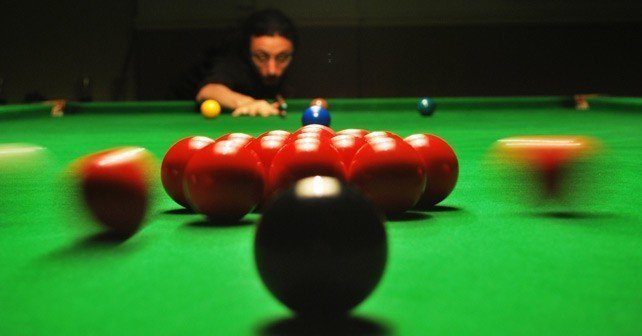Snooker is a game for either two players or two teams that involves the players using cues to pot the colored balls on the table and gain the highest score.
The player must use the (white) cue ball to hit, or pot, an object ball into a pocket.
The player must do this in a specific order of first a red, then a color, and so on to gain consecutive points (a break).
The red balls are worth one point, the yellow ball two, the green ball three, the brown ball four, the blue ball five, the pink ball six, and finally the black ball which is worth the most, seven.
The player also gives points to their opponent through fouling which can include: missing all balls, striking a color before a red, and getting the cue ball in the pocket.
Common Terms Used In Snooker
Scratching
When the cue ball is pocketed it is commonly referred to as “scratching”.
This stems from when the scores were kept on a blackboard, and when the player would pot the cue ball their opponent would literally “scratch” the player’s points from the blackboard.
147 Break
The highest break a player can get involves them potting a black after every red then potting all the colors consecutively.
This is called a 147, and is often believed to be the maximum break.
Free Ball
There is, however, a foul penalty when a player misses a red ball, and then snookers their opponent which occurs in something called a “free ball”.
This “free ball” rule means that the opponent can name a color to represent a red, pot it, and then pot a color meaning that if a “free ball” is offered with all the red on the table the maximum break is 155.
Snooker and Pool are widely considered to be one of the safest sports worldwide.
Snooker originated in India
It is widely accepted to have originated from India, having been developed from (English) Billiards, a game involving two cue balls and a singular object ball.
This is not, however, where Snooker is descended from.
The original inspiration for Snooker first came from Croquet, a game where colored balls are hit through hoops in the ground with a mallet.
So it’s easy enough to see how it inspired a game where colored balls are hit into the pockets of a table with a cue.
When first moved indoors, the balls were pushed (rather than struck) with “maces” – curved metal or wooden heads attached to the end of a narrow wooden handle.
The size of the maces made it difficult to achieve accurate shots and play and as a result, many people resorted to turning their handle’s around and using the narrow side to strike the ball.
People eventually noticed that this way yielded more efficient results, and this is how today’s cue we know – and love – so well were developed.
As cues became more advanced so did the tips.
Players would often rub chalk on their cue tips in order to give them more control over the cue ball.
Despite still being called “chalk”, the modern “chalk” contains no chalk at all and actually consists of many different fine abrasives!
The earliest recorded Billiards table dates back to 1740.
The table was owned by King Louis XI of France.
It was made of stone, with one large hole in the center, and despite its differences to contemporary Snooker tables, it was still covered in a green felt akin to the felts of modern tables.
All early Snooker balls were originally made of ivory, but in the 1920s synthetic balls started being made.
Some of these synthetic balls contained some of the elements used to make gunpowder, and yes, as a result, they sometimes had a tendency to explode when hit!
For some reason, this caused these balls to quickly become unfashionable.
Today’s balls are made of resin or plastics.
Snooker Competitions
Within the world of Snooker, there are both male and female competitions held.
The world’s first recorded woman Snooker champion was a man, though!
Frances Anderson dominated the female game for roughly 25 years winning all the major championships in the female Snooker circuit.
Eventually, her/his true identity was revealed as Orie Anderson although some say she/he was so convincing that it wasn’t until their death that they were discovered by an undertaker at the mortuary!
One of snooker’s all-time greats is seven-time World champion Stephen Hendry who, like many other players, used the same cue for all his major tournaments.
This famous cue of his was destroyed in 2003 sadly when it emerged from the cargo hold of a plane in pieces in Thailand. Needless to say, Stephen was devastated!
What made this even more painful for Stephen was that it was the second famous cue of his to cause him problems, as he had once paid a £10,000 ransom to thieves in order to get back a treasured cue of his!
The Longest & Shortest Games of Snooker
Unlike some sports, Snooker can often transpire over a long period of time.
The longest ever frame (single game) of Snooker was played between Shaun Murphy and Dave Harold in 2008 in Beijing during the 2008 China Open and lasted a whopping 93 minutes and 12 seconds!
On the other hand, the shortest frame of Snooker lasted only 3 minutes and was won by Tony Drago in 2009, Drago was a pleased well-known for his quick breaks and was often penalized by officials for not waiting for all the balls to stop moving before playing his next shot.


















